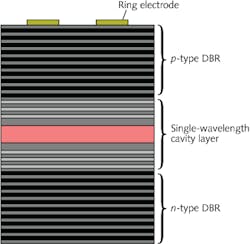POLARITON LASERS: Two groups demo electrically powered polariton lasers
A new type of low-power semiconductor laser has reached an important milestone—the first electrically powered operation. Two independent groups described strikingly similar demonstrations in reports published within hours of each other on May 15, 2013, in Nature and Physical Review Letters.1, 2 Neither group knew about the other’s success until they saw the papers.
Atac Imamoglu of the Swiss Federal Institute of Technology (Zurich, Switzerland) in 1996 proposed the concept of extracting coherent, monochromatic light from polaritons, which are quasiparticles formed by the interaction between a photon and an electron-hole pair (exciton) in a semiconductor. Polaritons are bosons, so many of them can occupy the same quantum state, creating a condensate similar to a Bose-Einstein condensate. Polaritons in these states have subnanosecond lifetimes, spontaneously decaying by releasing a photon. Because all polaritons in a condensate occupy the same quantum state, the emitted photons are coherent
and monochromatic.
Potentially very efficient
Theory predicts high polariton-laser efficiency at low powers, making them attractive for applications such as optical interconnects. The polariton mechanism does not require a population inversion, says Alexey Kavokin of the University of Southampton (Southampton, England). “That is why we expect thresholds maybe orders of magnitude lower” than conventional semiconductor microlasers, he notes. Polaritons also promise very high speed. It took just two years for the first polariton laser to be demonstrated by optical pumping of a cryogenically cooled semiconductor microcavity. Kavokin’s group was the first to demonstrate optical pumping at room temperature in 2007.3
Shifting to electrical pumping required major changes, starting with doping the microstructure to produce a p-n junction and conduct current. The logical semiconductor for experiments was gallium arsenide (GaAs) because its technology is well developed, and light emission in a polariton light-emitting diode was developed in 2008.4 But developing a device that produced coherent, monochromatic laser light—and produced persuasive evidence that the light came from polaritons rather than from the laser-like microcavity—took considerably longer.
One key issue was the nature of the polariton excitation and condensation process. “It starts with creating an electron-hole plasma which generates a population of excitons, and these excitons then couple with photons in a resonant cavity to produce polaritons,” says Pallab Bhattacharya of the University of Michigan (Ann Arbor, MI), whose group described its approach in Physical Review Letters. However, a bottleneck can occur in scattering the polaritons to the lowest polariton energy levels, blocking production of the large coherent population of polaritons at the levels needed for coherent emission. Both groups overcame that problem by applying strong magnetic fields of several Tesla, increasing the scattering to overcome the bottleneck and help them demonstrate polariton-laser action.
Cooling was required
Bhattacharya says another issue is that in GaAs the exciton binding energy is relatively weak, so the excitons tend to fall apart well below room temperature, preventing polariton emission. That was solved by cooling the GaAs microcavities to temperatures of 10 to 30 K. Low temperatures showed the physics clearly, says Sven Höfling of the University of Würtzburg (Würtzburg, Germany), whose group reported its approach in Nature. Operating at higher temperatures will require semiconductors with wider bandgaps, such as nitride or II-VI compounds.
Proving that experiments actually demonstrated polariton lasing was a challenge because the microcavity diode strongly resembles a VCSEL, with a resonant cavity that could produce laserlike effects. Höfling says his group needed more than two years to convince referees that they were observing nonlinear emission from the polariton process, rather than a weakly coupled microcavity laser. “We saw all the signatures [of polaritons] without the magnetic field,” he says, but they had to add the magnetic field to make the observations definitive. Bhattacharya recalls some sleepless nights worrying if his group’s evidence was definitive. The simultaneous publication of independent results was an additional confirmation.
Some quibbling over definitions is still likely because, strictly speaking, the coherent output photons are produced by spontaneous emission from the coherent polariton states. Bhattacharya calls the process “light amplification by stimulated scattering of polaritons [LASSPs],” but it remains to be seen if polariton lasers will become LASSPs.
Both groups say their next steps will be trying to demonstrate electrical pumping at the higher temperatures needed for practical applications, with room temperature the ultimate target. That will require switching to wide-bandgap semiconductors such as gallium nitride or zinc oxide. Success would open the way for polariton use in applications where low power consumption is critical, such as optical interconnects, switches, and logic gates. Kavokin suggests polaritons might also generate terahertz frequencies. And Höfling is hoping that electrical excitation at room temperature also can generate polariton condensates—analogs of Bose-Einstein condensates that would be much easier to produce and use.
REFERENCES
1. C. Schneider et al., Nature, 497, 348 (May 16, 2013); doi:10.1038/nature12036.
2. P. Bhattacharya et al., Phys. Rev. Lett., 110, 206403 (2013); doi: 10.1103/PhysRevLett.110.206403.
3. S. Christopoulos et al., Phys. Rev. Lett., 98, 126405 (2007).
4. S. I. Tsintzos et al., Nature, 453, 372 (May 15, 2008); doi:10.1038/nature06979.

Jeff Hecht | Contributing Editor
Jeff Hecht is a regular contributing editor to Laser Focus World and has been covering the laser industry for 35 years. A prolific book author, Jeff's published works include “Understanding Fiber Optics,” “Understanding Lasers,” “The Laser Guidebook,” and “Beam Weapons: The Next Arms Race.” He also has written books on the histories of lasers and fiber optics, including “City of Light: The Story of Fiber Optics,” and “Beam: The Race to Make the Laser.” Find out more at jeffhecht.com.
